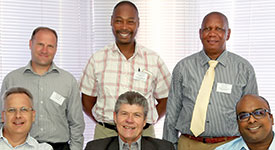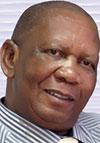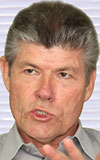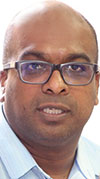
It’s easy enough to find success stories about surveillance installations from almost anywhere in the world. It’s also simple to get the specifications of various cameras, storage systems and management platforms. What is not so easy is to actually install and manage the installation and operations of a security system that relies in part or as a whole on surveillance.

Hi-Tech Security Solutions decided to ask a few people who have been on the sharp end of the surveillance industry, in other words, those involved in making it work and answering questions from the board when things go wrong, to tell us about the pros and cons they have come across in their daily jobs.
Fortunately, we managed to get a positive response from a number of high-profile surveillance experts to join our round table. Our guests were:
• Logan Naidoo, a consultant at CKR Consulting Engineers,
• Massimo Carelle, risk manager at Ingram Micro,

• Ruben Tshwene, technical director Westgate Super Regional Shopping Centre,
• Sydney Nonyongo, assistant operations manager at Westgate Super Regional Shopping Centre,
• Rian Giesing, head of security and safety at Rand Merchant Bank (part of the First Rand Group), and
• Gerhard van Den Bergh, national facilities and operations manager at Mowana Properties.
Starting off with the million-dollar question, we asked the round table attendees whether they could elaborate on the benefits they have attained through surveillance installations. More specifically, what have their systems delivered and how did they get to the stage where they were satisfied with the installation.
Not surprisingly, while the attendees were, in general, positive about the performance of their technology, the real benefits one gains is when the technology is part of a carefully planned security process that takes people, technology, and perhaps most important of all, carefully defined processes into consideration.

Van Den Bergh, who is in charge of a number of shopping centres, is reserved about the surveillance installations he manages. This is because there is no standard to the implementation in various centres. This means that one centre will have a sterling system that delivers precisely what management wants, while another will have a less functional installation that needs work before it will deliver as desired – an ongoing process at Mowana.
Despite that, he says the surveillance solutions in general are a definite benefit to centre management as well as shoppers. However, he also notes that what makes it work is the staff tasked with managing and running the system, as well as their interaction with other employees.

Giesing adds that, from the RMB perspective which is naturally different from the retail environment, the direct or immediate benefit is in the ability to do a review of footage and give business an immediate answer as a result of incidents, occurrences, accidents and similar events. In addition, the banking environment is more controlled and he therefore has the luxury of implementing specific standards in terms of technology, training and saturation of cameras per floor, which he admits is a great luxury.
The question of quality of technology also comes into play for all the attendees. It can be good to have the Rolls Royce equipment for all your needs, admits Van Den Bergh, but you don’t always need the absolute best to achieve what you want. Although he also notes that going for the cheapest option available is not a good solution either.
Cheap vs. quality

Naidoo’s experience has shown him that quality does count. He has clients that invested in quality cameras and are still using them 10 years later, while others who opted for cheaper brands find problems with the image after as little as three years. It’s not always necessary to choose the more expensive option, there are less costly options that will do the job required. But again, your selection must be based on your requirements, not price. There is always a cheaper option, but it is not necessarily going to deliver.
He provides an example of a retail environment where claims against the centre have been easily dealt with because the camera systems were designed to perform, not bought on cost. An individual claimed he had been mugged in the centre, not an impossible scenario in South Africa. However, the surveillance system was able to track this person from when they entered the mall to when they left – as well as a short time after he had left – and it proved he was not attacked in the centre.
And then there’s the story of a guard who was caught charging staff R5 per day to park inside a centre.
Of course, as others have noted, this type of quick solution relies on technology, but also on the personnel hired to manage the surveillance system. Their ability to use the management platform effectively is as important as the platform, cameras and other technology. And the training of staff to work as an unit when events occur is also critical.
Naidoo also mentions that there are many aspects to purchasing a solution, whether hardware or software. Even the most expensive Rolls Royce systems will need maintenance and repairs at some stage, and this is where local support and skills play a big role in the overall pricing. It is always wiser to pay more and get local expertise on call than to save upfront costs only to lose time and money waiting for overseas repairs or technicians.
A job description
The most important issue when looking at surveillance solutions, according to all the attendees, is to ensure that you know what you want. The days of simply installing a bunch of cameras in what you think is a good position are over – if they ever were here.

Carelle reverts to the old adage of “giving each camera a job description”. When you know what you want from each camera, you are in a better position to judge which technology is required and whether less costly brands will perform as required. Of course, as Giesing notes, customers don’t always know what they want.
This is especially important today with all the add-ons one can use in surveillance, whether they are classified as video analytics or something else. The value-adds one can build on top of the surveillance takes the security operation from a traditional reactive system that sets processes in motion once an event has happened, to a proactive one in which businesses can prevent some negative events.
Van Den Bergh highlights an example in the form of LPR (licence plate recognition). One mall in his group installed LPR and has reduced the number of stolen cars to zero in the first three months of having the system in place. In fact, it has also helped apprehend some criminals before they could even try to break into a car. Linking the system to the SAPS and other databases allows the centre to identify stolen or suspicious cars as they enter and alert the centre’s security teams.
Facial recognition is another add-on that is being tested at some public spaces such as retail locations. There have been some positive results, but time will tell if this functionality will further assist in making centres safer.

A key issue Nonyongo highlights is that, no matter what solution an integrator promises, purchase decisions and recommendations must also take into account that environments change constantly and what is the norm today may not be the norm tomorrow. Understanding and designing your environment well is therefore critical.
Education is key
No matter what the goal of your surveillance solution is, the key to success is education. In the first instance, it’s about educating the users or buyers in terms of what is possible and what is not possible. Looking at the value-added functionality mentioned above, your client would not know that a cheap camera system would not deliver the LPR or facial recognition results required. Similarly, if all you require is a view of the staff entrance, you don’t need the best camera on the market.
For those people who will be managing the surveillance installation, it is also important to educate their bosses as to what they can realistically expect to achieve. With television programmes like CSI, many people believe the impossible is only a click of a mouse away.
Then there is the question of staff training. You cannot simply take a few guards from the beat, put them in a control room and expect them to be good operators. They need proper training, and even more importantly, they need to have the right aptitude for the job. Then they need to be trained on the platform they are using to ensure the investment in the system pays off. Any system is a bad system if the operators are not capable of handling it.
Additionally, the staff in positions related to the surveillance, which can include guards, also need to be trained in the correct processes to follow when an event occurs. This, of course, means standard operating procedures (SOPs) need to be designed and implemented for all staff, from the control room to the perimeter in order to ensure they understand how to act and what makes an event normal or abnormal.
And this training extends to simple things such as reporting when a camera is out of focus, or a light bulb in an important area is out.
Nonyongo adds that training is often not enough as operators are put into situations where they simply can’t be effective. For example, they may be put in front of a number of screens they have to watch, without being given the regular breaks they need. This will result in them missing events due to exhaustion. And, of course, even the best and most motivated staff can only be of limited value when they are tasked with watching a large number of screens all day.
He suggests refining their tasks and using analytics to assist them will deliver a far better result. For example, motion detection in rarely used corridors will lighten their burden, as will specifying a small number of sensitive areas that they can focus on instead of tens of little video feeds on multiple screens.
Another educational area few people want to talk about is the impact of senior management on buying decisions. It’s not unheard of that a financial manager would query the cost of an installation because he or she knows you can get a cheaper camera or service provider. In these scenarios, Nonyongo suggests taking them out of their offices and on a tour of the site in order to help them understand why you want the solutions you have asked for.
Van Den Bergh agrees, noting that your operations department needs to know what they are doing if they are going to be able to convince management that the solution doesn’t just boil down to cost cutting. You may even find they have statistics to throw at you saying how many cameras or guards are standard in an environment like yours.
Again, knowledge of your situation assists in convincing them otherwise. Giesing notes that you need to work from a well-devised plan that incorporates your entire site. If you don’t cover everything from the beginning, you will continually be running backwards and forwards adding bits and pieces. Similarly, the security operations team needs to know about the company’s expansion plans to allow it to incorporate those changes in future security strategies.
Standards and regulation
An issue which was also raised by all of the attendees, and which is raised in almost every round table the security industry is involved in, is that of regulation and standards. The participants asked how they could know whether a company they were planning on hiring would fulfil its role effectively and not leave then with a second rate installation they would have to pay another company to fix.
The stories of failures they mentioned came from both large integrators and smaller installers, as did the stories of success. There is therefore no way to know whether the company you hire will deliver unless you first do your homework and check every potential service provider’s credentials and their past history by talking to older customers, especially when dealing with large sums of money. However, at the end of the day, you need to take a subjective decision since there is no public forum to rate installers and integrators, and one can’t rely on the certification of the industry regulator for much more information than that they have paid their fees.
This sad state of affairs means everyone, from experienced installers to your local electrician can offer to install CCTV cameras with no formal qualifications or training. Even security-specific installers can run into problems without the right experience and skills. A VMS system might say it is able to handle 94 cameras, for example, but Naidoo asks if that means all 94 are running at maximum resolution? And then what about your network? Can it handle all that footage all at once? And can your servers and storage deal with the maximum?
One option in dealing with this type of scenario that Nonyongo and Van Den Bergh suggest is a rental plan. In this scenario, the customer does not put a large sum down and purchase the solution outright, but contracts to rent or lease the system for a monthly fee over a number of years.
The benefit of this type of deal, apart from a capex expenditure perspective, is that the integrator puts the money in up front and only makes it back over the number of years the contract is valid for. It also allows the customer to set up service level agreements (SLAs) in terms of what cameras should be doing and what reaction times to support queries will be etc. A carefully designed contract will also allow for penalty clauses through which the customer can claw back money for services not delivered.
An industry that has done a good job of dealing with the lax regulatory environment in South Africa is the fire industry. The associations in this industry have made sure that fire installers and their companies need to be certified, and there are penalties if they break the rules.
Here again user education is important because the end user, the paying customer, ultimately decides which company to use and if they do not understand what benefits come from using certified service providers, the cheapest option will win and the result could be a disaster.
This does not, however, excuse your need to get good people on board. Giesing explains that people can make a poor system succeed and a good system fail. In his environment, he identified a couple of people with the right aptitude and attitude and has been training them and moving them up the ladder for a number of years. The result is people who know the environment and exactly what they need to do to get the results they require.
Service provider support
A final topic the round table attendees mentioned concerns their service providers. While the debate over insourcing or outsourcing continues, in many instances informed by the industry our attendees operate in, many make use of service providers in some form. However, there is a key element missing from the services these companies provide.
The SLA is this key. And even though the service providers agree to the SLA contract, if they were enforced strictly, there would be regular and large penalties to pay. Whether this lack of adherence is due to poor training or supervision, hiring cousins or friends, or for whatever other reason like the customer not enforcing the SLA, it is an issue all companies face.
Then there is the concern about service provider hiring practices. Despite the efforts of some associations, one often finds someone who is fired from a security service provider for a serious offence simply moves on to the next security operator and gets a similar job there, his experience at his previous employer counting in his favour. And while this is common in some guarding circles, it is not unheard of in control room operations.
For those who take responsibility for their own personnel, hiring the right people and continual training is a crucial element of their success on the job in the short and long term. Effective employees enhance the security system and develop a trust relationship over time, enhancing their own work experience and environment.
When one distils the comments made by the various round table attendees, it becomes clear that there are many issues they need to deal with in their daily jobs which don’t necessarily have to do with their management’s goal of keeping people and assets secure. It’s a job with a broad focus, and only one of the things to pay attention to is technology.
Some of the problems faced could be lightened if the South African security environment was one in which regulations were enforced as a norm. Interestingly enough, there are actually enough regulations, just no enforcement from the regulatory bodies and in most instances from the industry bodies as well.
Despite all this, the job still needs to be done and there are many opportunities for third-party companies to deliver services and advice, as long as they take the time to understand what the client wants and how best to deliver. Getting your ducks in a row before going on a sales drive costs time and money, but pays off in the end.
Hi-Tech Security Solutions would like to thank our attendees at this year’s round table for their time and input. As with all articles like this one, much information could not be included due to space restrictions, but with jobs as broad as those the attendees have, a few pages can’t do them justice.
| Tel: | +27 11 543 5800 |
| Email: | malckey@technews.co.za |
| www: | www.technews.co.za |
| Articles: | More information and articles about Technews Publishing |
© Technews Publishing (Pty) Ltd. | All Rights Reserved.